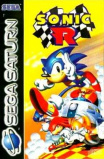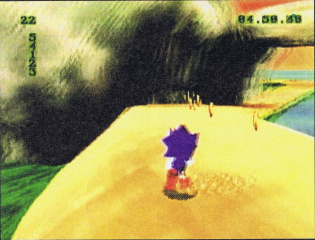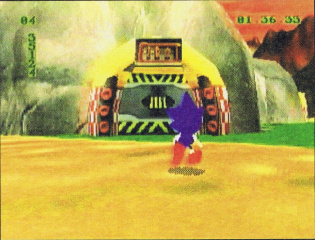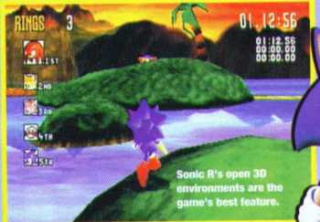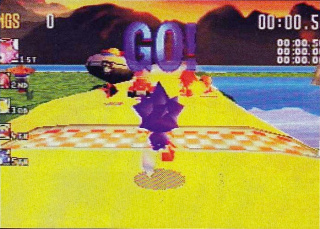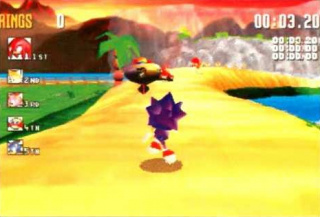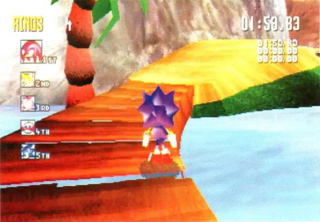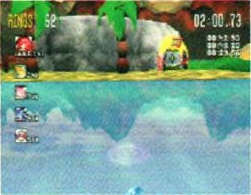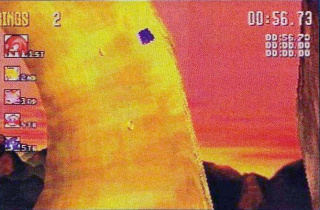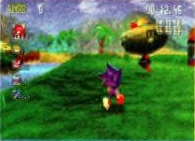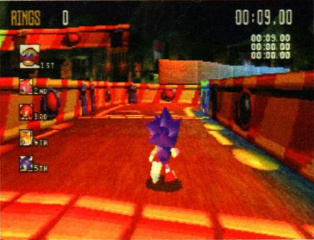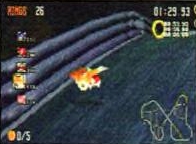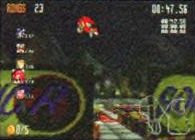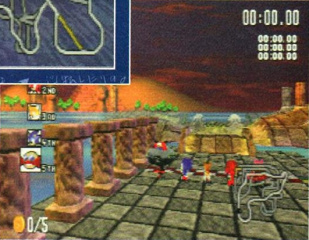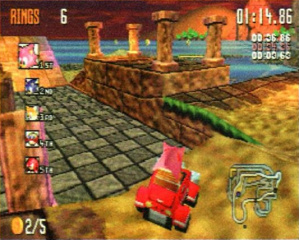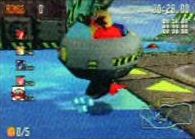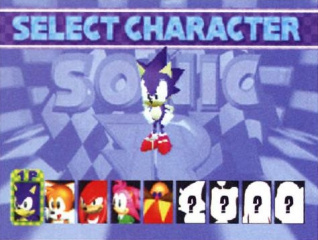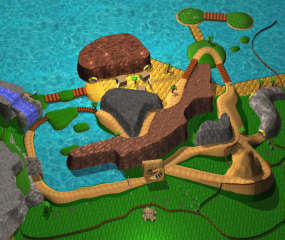Sonic R/Development
From Sonic Retro
- Back to: Sonic R.
Sonic R had gone through several changes over its development process. There are several rejected ideas, level designs, and other things that were changed before the games final release. The following details several of these things.
Contents
Development process
Sonic R was the second Sonic the Hedgehog-related project to be entrusted to Traveller's Tales, a British studio previously responsible for Sonic 3D: Flickies' Island in 1996, and host of other projects prior. Many of the core members of the Traveller's Tales staff worked on both projects, including studio head Jon Burton (design and programming) and lead artist James Cunliffe. Similarly to Sonic 3D, the project was overseen by members of Sonic Team - Sonic Team would outline the requirements and provide feedback, and Traveller's Tales would implement their demands.
Sonic R began its life as a Formula One game, still developed for Sega, but without the Sonic license. Traveller's Tales' "arch rivals" Bizarre Creations had released the extremely popular PlayStation game Formula 1 in 1996 (and would coincidentally be picked up to create the Sega Dreamcast game Metropolis Street Racer on the grounds of its success), and Sega wanted a response from the studio, who got to work on this project shortly after.
The team spent a few months working on the Formula One project (writing an engine and even producing 3D assets) before the troubled Sonic X-treme was cancelled. This led to Sega cancelling the Formula One project in its original form, and tasking Traveller's Tales with adapting the engine into a Sonic racing game in time for Christmas 1997.
For a while, Sonic R was referred to as "Sonic TT", with the source code still making reference to that original title. This was not a nod to Traveller's Tales, but was to fit in with other racing terms such as "Time Trial" or "Tourist Trophy" (and Manx TT SuperBike released by Sega two years prior).[1]
Sonic Team designed all the tracks on paper, which Traveller's Tales would convert into 3D models. Some of the original texture work resembled the look of Sonic 3D, particularly with its distinctive bushes, but the artwork had been completely redone by the final game.
The game appeared at E3 1997 in a playable form, however Jon Burton noticed that people were giving up when Sonic ran into the water, on account of his underwater speed being so slow. This was sped up in response.
A "relay" mode was once planned, wherein each lap of the course would be completed by a different character. A mirror mode, where the tracks would be flipped, was also considered, but according to Jon Burton, was scrapped due to the draw code having to be re-written to compensate for the changes.
The in-game player models originally had a higher polygon count, but were adjusted for performance reasons. The result of these changes is that Tails lost his whiskers and hair, Knuckles curiously gained a different pair of shoes, and Robotnik's missile system was simplified, being turned into a cannon rather than a claw/missile contraption. Amy perhaps had the most radical redesign, however, having originally been given a giant circular saw at the front of her car to attack her opponents. In addition to this, the vehicle had a rear spoiler - it is missing in-game but continues to appear in promotional renders.
A planned Flame Shield was also removed from the game after it was considered to be too similar to the Lightning Shield in design.
Music
As one of the first big-budget titles with a dedicated vocal soundtrack, programmer Jon Burton persuaded management at Sega to also include instrumental versions of the game's songs, as he wasn't sure how receptive players might be to a Sonic game with lyrics in it. Once added, Burton initially defaulted the "Vocals" option to OFF; however, he recalls that "as I heard the tracks more and more I realized what the rest of the world already knows: the Sonic R soundtrack with lyrics is amazing."[1] In the final game, the "Vocals" option is instead defaulted to ON.
Prerelease footage of Sonic R shows the Resort Island track taking place during sunset. Combined with the later Windows PC port having a time of day feature, this led to community speculation regarding the original Saturn version originally having a similar feature. However, Burton recalls that during development, the background was changed to instead take place during a sunny daytime hour, as the track's music ("Can You Feel the Sunshine?") would be thematically out of place during a calm sunset - additionally confirming the Saturn version never had a time of day feature.[1]
Prototype cover artwork
This early box art was found on Compuserve internet servers back in 1998. The artwork here is found in the ending scene in the game, and appears in earlier prototype title screens. It was rejected as it gave away that Metal Sonic was a secret character in the game.
Prototypes
Version 0.1
A YouTube channel by the name of GameHut, which was created by Jon Burton of Traveller's Tales, had shown off the earliest version of Sonic R, dubbed Version 0.1. This tech demo has a first person perspective and shows off an unused level.
Version 0.2
A second version of the game, named Version 0.2, was also showed off by Jon Burton. This build shows the earliest known iteration of Resort Island, with many missing textures and a test background ripped directly from the "Moose Hunters" level in Mickey Mania: The Timeless Adventures of Mickey Mouse, another Traveller's Tales game. There are multiple non-animated Sonics moving around the track, and the player can control one of them, but can only move him forwards or backwards on a fixed path. Rings are present at the start of the course, but cannot be collected.
Version 0.3
Jon Burton also showed off a later version of the game which he called Version 0.3. This version allows the player to control Sonic without any running animations around an early version of Resort Island. In this build, Rings become collectable.
Early public prototype
Sonic R was meant to be kept under wraps until E3 1997, however an earlier prototype made it into some portions of the press. At this point, Sonic had been given animations and the game was starting to take shape, but this build is far from polished. As well as having an incredibly simple HUD, it is not known if any other levels and racers aside from Sonic and Resort Island were implemented at this point.
Judging from the numbers, it appears Sonic can pick up rings now.[2]
He can also walk on water.[2]
100 rings to get through this door? The final only wants 50.[2]
Pre-E3 1997 build
Sonic R was announced to the world at E3 1997[3]. Two builds were visible, the earlier of which was used to create pre-recorded footage which was sent to the press. It can be identified by the soles of Sonic's shoes being red. While this version has a more appropriate HUD, it is using non-final icons and some elements have yet to be implemented.
E3 1997 build
On the show floor, a "20% complete"[4] build was playable, in which players could race Sonic around Resort Island. No other characters were selectable[3] but were still in the race, being controlled by the computer.
Footage suggests this build had no voice over for the initial countdown, and that a non-final version of "Super Sonic Racing" was used as the in-game music. It was observed by Jon Burton that players would frequently fall into the water and then stop playing, as traversing in this state was slow and cumbersome. It was sped up for the final game as a result of this.
Start the demo and within fractions of a second, all of the other racers have ploughed ahead. As these screenshots show, players had a hard time keeping up with Knuckles.[8]
Sonic has white shoe soles in this prototype, which were changed back to red before the final game. Robotnik also has a different style of missile.[10]
The bubble shield works.[10]
The upper path is accessible.[3]
At this point, Resort Island is virtually complete, though extra signs were added in later builds.[4]
The right path.[10]
The left path.[12]
A 40 ring door. The final wants 20.[11]
The door works...[4]
...but there's nothing to see in the tunnel.[4]
The electric shield is a darker shade of red, looking more like the scrapped fire shield.[3]
80 ring door. Final wants 40.[6]
There is only one line of rings around this loop. The final game is covered in them.[11]
The UK's Sega Saturn Magazine demonstrating the fading in of polygons.[10]
August(?) 1997 build
Two months later a second demo was released to the press[13]. Sonic was still the only selectable character in single player[14] but two more tracks were playable - Radical City and Reactive Factory[14]. A 2-player versus mode was also included[15], with the second player controlling Tails[16].
Resort Island is now taking place in the middle of the day, rather than sunset.[15]
Sonic's opponents still launch off the starting line at full speed.[13]
While the backgrounds have changed, the shading on geometry is still optimised for the old sunset look. This means all the characters have a dark orange tint to them.[13]
Tokens exist, but they're not thought to do anything.[17]
Singposts are still missing.[14]
Another strangely placed token.[18]
Electric shield is still red.[18]
The starting line would later move to this initial archway, which leads to AI characters getting briefly stuck. The final game positions the players further back, and adjusts the geometry so players can easily filter into the tunnel.[15]
The old Resort Island lighting affects characters in these stages too, although being set at night, it almost works on this track.[14]
Sonic hasn't picked up any rings in any of these Radical City or Reactive Factory screenshots, suggesting there aren't that many on these tracks yet.[15]
Traveller's Tales would change a lot of the lighting by the final product. This yellow lit section is purple in the final game.[13]
Rings do exist, but they're hidden away.[20]
The different starting line explains some of the strange readings on the timer.[15]
Other lights seem to be a bit brighter in this prototype, although it's not always easy to tell.[13]
Road markings are missing.[13]
The slot machine has yet to be implemented, and this wall to the left is excessively yellow.[18]
If Robotnik is in first place and Sonic is in fifth, where are Amy, Knuckles and Tails hiding?[14]
Robotnik clipping through the floor.[14]
Found Tails - he's standing on thin-air under some geometry as Sonic hovers overhead. It's not the most flattering of screenshots.[20]
2-player mode, featuring purple Sonic and red Tails. The HUD layout is different to the final.[18]
Preview
| |
Main article: Sonic R (Saturn prototype; 1997-09-10) |
September(?) 1997 build
Traveller's Tales put out a third public demo four weeks after its second, this time with five playable characters and the addition of Regal Ruin[21]. This version added the mini-map at the bottom right hand side of the screen and the collectable coins[21], as well as the ability for Sonic to double jump[22]. 2-player mode was still restricted to Resort Island, some powerups were non-functional and the replay mode was not always stable[23].
All players are represented on the mini-map as grey dots, rather than with their own colours as seen in the final game.
Final fonts, and other racers aren't shooting off the starting line.[21]
The larger icons are representing the player now.[22]
A mysterious red ball. Robotnik's weapon?[22]
Regal Ruin. In the final game, some of the pillars on the left have torches on top.[25]
More missing torches.[21]
Miscellaneous
Computer and Video Games magazine printed this screenshot during their review of Sonic R, showing the unlockable characters with white silhouettes. While most likely doctored by the magazine, we can't say for sure (or indeed why they would want to).[26]
Full map renders
The following renders were publicly shared by Jon Burton via YouTube video on January 12, 2018:An early render of Resort Island's map.
An early render of Radical City's map.
An early render of Regal Ruin's map. It's missing pillars in the water at the start of the track, more sand is present on the top of the model, and the loop is larger.
An early render of Reactive Factory's map.
References
- ↑ 1.0 1.1 1.2 https://www.youtube.com/watch?v=y4Wgqqi5uj8
- ↑ 2.0 2.1 2.2 [megaforce, issue 58, page 46 megaforce, issue 58, page 46]
- ↑ 3.0 3.1 3.2 3.3 3.4 3.5 3.6 3.7 File:SSM UK 22.pdf, page 19
- ↑ 4.00 4.01 4.02 4.03 4.04 4.05 4.06 4.07 4.08 4.09 4.10 4.11 File:SSM UK 22.pdf, page 21
- ↑ 5.0 5.1 5.2 5.3 File:SegaMagazin DE 46.pdf, page 18
- ↑ 6.0 6.1 6.2 6.3 6.4 File:ConsolesNews FR 14.pdf, page 40
- ↑ 7.0 7.1 7.2 7.3 File:SegaMagazin DE 46.pdf, page 17
- ↑ File:SSM UK 24.pdf, page 19
- ↑ File:SegaMagazin DE 46.pdf, page 15
- ↑ 10.0 10.1 10.2 10.3 10.4 10.5 10.6 File:SSM UK 22.pdf, page 20
- ↑ 11.0 11.1 11.2 11.3 11.4 11.5 File:ConsolesNews FR 14.pdf, page 41
- ↑ 12.0 12.1 File:SSM UK 22.pdf, page 22
- ↑ 13.0 13.1 13.2 13.3 13.4 13.5 13.6 13.7 13.8 File:SSM UK 24.pdf, page 21
- ↑ 14.0 14.1 14.2 14.3 14.4 14.5 14.6 File:SSM UK 24.pdf, page 22
- ↑ 15.00 15.01 15.02 15.03 15.04 15.05 15.06 15.07 15.08 15.09 15.10 15.11 File:SSM UK 24.pdf, page 23
- ↑ 16.0 16.1 16.2 16.3 16.4 16.5 File:SSM UK 24.pdf, page 24
- ↑ 17.0 17.1 17.2 17.3 17.4 17.5 17.6 17.7 File:SegaMagazin DE 48.pdf, page 19
- ↑ 18.0 18.1 18.2 18.3 18.4 18.5 File:SegaMagazin DE 48.pdf, page 20
- ↑ File:SegaMagazin DE 48.pdf, page 18
- ↑ 20.0 20.1 20.2 File:SegaMagazin DE 48.pdf, page 21
- ↑ 21.00 21.01 21.02 21.03 21.04 21.05 21.06 21.07 21.08 21.09 21.10 File:SSM UK 25.pdf, page 67
- ↑ 22.00 22.01 22.02 22.03 22.04 22.05 22.06 22.07 22.08 22.09 22.10 22.11 22.12 File:SSM UK 25.pdf, page 68
- ↑ 23.0 23.1 23.2 23.3 23.4 23.5 23.6 23.7 23.8 23.9 File:SSM UK 25.pdf, page 70
- ↑ File:CVG UK 193.pdf, page 72
- ↑ 25.00 25.01 25.02 25.03 25.04 25.05 25.06 25.07 25.08 25.09 25.10 File:SSM UK 25.pdf, page 69
- ↑ File:CVG UK 193.pdf, page 74
| Sonic R | |
|---|---|
|
Manuals |
show;hide
Books:
Music: Songs: "Super Sonic Racing" | "Can You Feel the Sunshine" | "Living in the City" | "Back in Time" | "Work it Out" | "Diamond in the Sky" | "Number One" |

